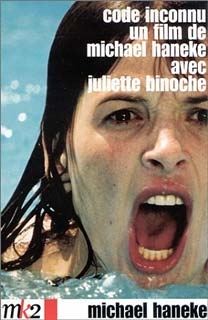Tuesday, February 15, 2011
Code Unknown. (2000) Michael Haneke
A melting pot of social, racial and biological interactions, with injustice and violence and voyeurism thrown into the mix, Code Unknown is a film about owning up to the mystery of human relationships -- how we stumble to connect through the maze of our own expressions. The film's continual emphasis on cameras, and on the deaf and their sign language is a reminder that gestures carry just as great a weight; that symbols are as important as words.
On a business day on a crowded Parisian street, Anne (Juliette Binoche, outstanding as always), a local actress, is surprised by her lover's little brother, Jean, who has run from his father's home and needs the code to get into her flat. She loans him the key with a stern reminder that the place is small and that his stay will be short-lived.
On his way back to her flat he discards a wrapper on the lap of an immigrant woman sitting in the street. He is immediately challenged by a young black man, Amadou, about the rudeness towards the woman. Amadou seems interested in justice and demands that Jean apologize to the woman, who at this point seems to want to get away from the developing scene. The hardened kid refuses an apology, a street scuffle ensues and the police are quickly on the scene.
In the first key misfire in deciphering a social disruption (a sort of "code"), the police arrest Amadou and the immigrant woman is detained, and later put on the next plane out of France. Sometimes you speak for justice only to create a larger, more alienated mess. The scene cuts away suddenly, as do many scenes in the film, leaving you wondering how the strange event ended up.
The story picks up with Anne’s acting career -- she is constantly in front of cameras and directors (her photographer-lover Georges is out of the country snapping war photos for a feature in a respected journal) -- and several immigrant families and their isolation in a Paris that, for them, is harder to live in than they thought.
The fragmentation of society and the isolated lives within it are at the film’s central themes -- regardless of the social or economic status of the individual.
At one point Anne stands on an empty, dark theater stage in an audition for an upcoming production. For several minutes in a static, still shot, she gives her lines in character, giggling and laughing hysterically, absorbed in the lively role. At the end of her lines the room is silent and still. With the spotlight in her eyes, she can't see anything in the room. "Anyone out there?" she questions, and it feels like the central question of the film. Yes, the director and his assistant are still there. Yes, they've seen and are evaluating her scene. She waits like a refugee for an answer.
And yet in another brilliant moment the film counters the notion that we're alone, that someone will be there in the middle of our need. On the subway, Anne is later threatened and intimidated by some kids with nothing better to do but act like jerks to traveling passengers.
Their intentions are not known, but one of them gets a taste for barking at Anne and abusively follows her around on the car. When he gets nothing but the silent treatment, he goes so far as to spit in her face. A man she's never met takes a great risk and stands up to the kid. He stands the kid down, and when the kid gets off, Anne, who has been courageous up to this point, finally falls apart in tears. A stranger has just come to her aid.
There are particular things to watch for in the minimalist editing and camera movement in Code Unknown. The film is based on a series of one-takes which lends an honesty to the way the story develops. There's no deception in the image, and no soundtrack to manipulate the viewer. The well-acted scenes are relayed in a pure way; they live and die by the strength of the acting.
The camera also follows this route in aiming for full disclosure, almost moral in its use of tracking and still shots, in prolonged takes that are horizontal in motion in honor of human connectivity and concern. Watch for movement that sweeps from right to left, and back, until one of the final, lingering images, where an unknown code is lost while a key character gazes skyward.
As Georges says, when going through photos from a recent trip: "It's easy to talk about the 'ecology of the image,' and 'value of the non-transmitted message.' What matters is the end result." It sounds like the resolute words of our story-teller, director Michael Haneke, on his most honest and well thought-out film to date.
Subscribe to:
Post Comments (Atom)



No comments:
Post a Comment
I like to respond to comments. If you keep it relatively clean and respectful, and use your name or any name outside of "Anonymous," I will be much more apt to respond. Spam or stupidity is mine to delete at will. Thanks.